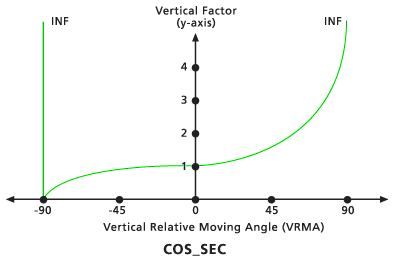Available with Spatial Analyst license.
Summary
Defines the relationship between the vertical cost factor and the vertical relative moving angle (VRMA) through a cosine/secant function. If the VRMA is negative the vertical factor is defined by a cosine function, and if the VRMA is nonnegative the vertical factor is defined by a secant function.
Illustration

Discussion
The VfCosSec object is used in the Spatial Analyst tools Path Distance, Path Distance Allocation, and Path Distance Back Link.
The vertical factor (VF) object defines the relationship between the vertical cost factor and the vertical relative moving angle (VRMA).
VF defines the vertical difficulty encountered in moving from one cell to the next.
VRMA identifies the slope angle between the FROM or processing cell and the TO cell.
When the VRMA is a negative degree value, the VF is determined by the cosine function of the VRMA. If the VRMA is a positive degree value, the VF is determined by the secant function of the VRMA.
Syntax
VfCosSec ({lowCutAngle}, {highCutAngle}, {cosPower}, {secPower})| Parameter | Explanation | Data Type |
lowCutAngle | The VRMA degree defining the lower threshold, below which (less than) the VFs are set to infinity. (The default value is -90.0) | Double |
highCutAngle | The VRMA degree defining the upper threshold, beyond which (larger than) the VFs are set to infinity. (The default value is 90.0) | Double |
cosPower | The power to which the values in the cosine VRMA function will be raised. The VF is determined by: (The default value is 1.0) | Double |
secPower | The power to which the values in the secant VRMA function will be raised. The VF is determined by: (The default value is 1.0) | Double |
Properties
| Property | Explanation | Data Type |
| lowCutAngle (Read and Write) | The VRMA degree defining the lower threshold, below which (less than) the VFs are set to infinity. | Double |
| highCutAngle (Read and Write) | The VRMA degree defining the upper threshold, beyond which (larger than) the VFs are set to infinity. | Double |
| cosPower (Read and Write) | The power to which the values in the cosine VRMA function will be raised. The VF is determined by: | Double |
| secPower (Read and Write) | The power to which the values in the secant VRMA function will be raised. The VF is determined by: | Double |
Code Sample
VfCosSec example 1 (Python window)
Demonstrates how to create a VfCosSec class and use it in the PathDistance tool within the Python window.
import arcpy
from arcpy import env
from arcpy.sa import *
env.workspace = "C:/sapyexamples/data"
myVerticalFactor = VfCosSec(-90, 90, 1, 1)
outPathDist = PathDistance("source.shp", "costraster", "", "", "", "",
myVerticalFactor)
outPathDist.save("C:/sapyexamples/output/pathdistvsc")
VfCosSec example 2 (stand-alone script)
Performs a PathDistance analysis using the VfCosSec class.
# Name: VfCosSec_Ex_02.py
# Description: Uses the VfCosSec object to execute the PathDistance tool
# Requirements: Spatial Analyst Extension
# Import system modules
import arcpy
from arcpy import env
from arcpy.sa import *
# Set environment settings
env.workspace = "C:/sapyexamples/data"
# Set local variables
inSourceData = "source.shp"
inCostRaster = "costraster"
# Create the VfCosSec Object
lowCutAngle = -90
highCutAngle = 90
cosPower = 1
secPower = 1
myVerticalFactor = VfCosSec(lowCutAngle, highCutAngle, cosPower, secPower)
# Check out the ArcGIS Spatial Analyst extension license
arcpy.CheckOutExtension("Spatial")
# Execute PathDistance
outPathDist = PathDistance(inSourceData, inCostRaster, "", "", "", "",
myVerticalFactor)
# Save the output
outPathDist.save("C:/sapyexamples/output/pathdistvsc2")